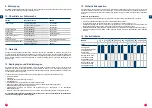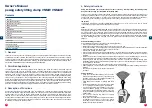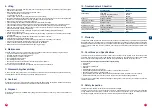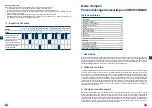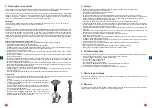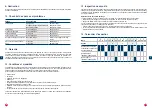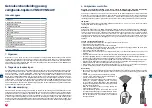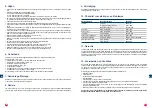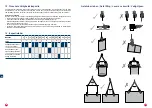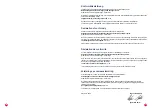
E
E
9
8
Owner’s Manual
pewag safety lifting clamp VNMW VNMAW
Contents
1. General
Thank you for choosing one of our high-quality products. The quality systems of management and services of pewag
austria GmbH fully comply with ISO 9001 standards. The many years of vast experience are a guarantee of optimum
quality and safety. pewag lifting clamps are manufactured from high quality alloy steels and comply fully with all
relevant standards and product requirements including: European standard: EN 13155, Australian standard: 4991,
US standard: ASME B30.20-2010 and Machinery Directive 2006/42/EG.
2. Permitted Applications
The pewag VNMW clamp has been equipped with two clamping jaws, which have been provided with a special
plastic cover. The clamp is used for hoisting, turning, or vertically transporting of work pieces and ensuring they
remain undamaged during the process. These pieces may be made from various materials, such as stainless steel,
aluminium, wood or stone, but with the exclusion of coarse concrete. After hoisting, the clamp will not leave any
signs of damage. The clamp is locked in both the open and the closed position. Using the pewag VNMW safety lifting
clamp, you may only transport or hoist a single plate at a time. The safety clamp has been equipped with a safety
locking device, allowing the load to be safely lifted and vertically transported at all times. To hoist the above-mentioned
materials, the VNMW safety clamps may be applied individually or as a pair, or multiple clamps simultaneously. To
ensure a balanced load distribution across the lifting clamps, we recommend using an equalising device when using
more than two clamps. Additional technical documentation is available from the manufacturer.
3. Description of Functions
Correctly and fully position the opened clamp onto the plate in such a way that the clamp’s clamping blocks are in
full contact with the plate. Apply the safety locking device. The clamp will close and hold the plate in the pretensioned
position. Lifting force may now be applied. When the load has reached its destination, the safety clamp may be
removed. To do so, lower the crane hook until the clamp is fully unloaded. This can be verified by the slackness of the
hoisting chain and a free movement of the clamp’s lifting eye and chain. Next, move the safety locking device towards
the clamping blocks. This will open up the clamp and leave it in the opened position. The clamp may be used again
immediately, or stored in the opened position.
4. Safety Instructions
Safety first! Guarantee your personal safety and that of others by carefully reading the following safety
instructions before using your new VNMW safety lifting clamp.
Ensure your own safety and continue to benefit from our product safety by having the clamp inspected, tested, and, if
necessary, overhauled at least once (1x) a year by pewag austria GmbH or another authorised mechanical repair and
service centre. See also Chapter 8 – Overhaul. It is not permitted to make any structural modifications to the clamps,
for example by means of welding or grinding. Please contact pewag austria GmbH for further information.
Temperature
The operating temperature of the pewag VNMW clamps lies between –10 °C (14 °F) and +30 °C (86 °F) . Please
consult with your dealer if other ambient temperatures are applied.
Loads
Because of their deep jaws, VNMW lifting clamps are especially suited to the hoisting of split plates. Never place the
clamping jaws onto tapered or conical surfaces. If the crane hook is not secured, and/or if it is too large and heavy,
it is recommended to use a chain sling with D-shackle with a length of approximately 75 cm (30 inch) and with load-
bearing capacities suitable for the specified working load limit (WLL) of the clamp. This will prevent the crane driver
from lowering the hook too far when putting down the load, which could cause the hook to disconnect from the lifting
eye. When attaching directly onto a secured crane hook, make sure the crane hook is able to move freely within the
lifting eye.
Avoid life-threatening situations
Avoid life-threatening situations by observing the following guidelines:
• Never operate with an untested lifting clamp.
• Always keep a safe distance when hoisting and never stand under the load.
• Do not use the clamp if it is damaged. Have the clamp repaired by pewag austria GmbH or another authorised
mechanical repair centre. When in doubt: contact your supplier.
• Never hoist more than one plate at a time.
• Never hoist loads heavier than the working load limit (WLL), as clearly indicated on the clamp and the test certificate.
• Never hoist loads that are thicker or thinner than the clamp opening, as clearly indicated on the clamp and the test
certificate.
• When using more than one lifting clamp at the same time, arranged in a row, provide lifting slings or chains of a
sufficient length to ensure that the angle between the slings or chains does not exceed 60 degrees.
• When using more than one lifting clamp at the same time, arranged in parallel, use a trussed hoisting girder
(equalising traverse girder) and sufficiently long lifting slings or chains, so that the lifting eye of the lifting clamp is
never subjected to lateral load.
• Never place the clamp onto tapered or conical parts of the load to be hoisted.
• Remove all grease, oil, dirt, corrosion and contamination from the plate at the point where the lifting clamp is to be
attached.
• The clamp is only suitable for use in normal atmospheric
conditions.
Safety precautions
• A free fall or uncontrolled swaying at the crane hook
resulting in objects being struck may cause damage to
the clamp. If this occurs, check whether the clamp is in
good working order before further use.
• Lifting clamps are not suitable for creating permanent
joints.
• Preventive maintenance of the clamp should be carried
out on a monthly basis. See Chapter 6 - Maintenance.
• Do not perform structural modifications to the clamp
(such as by welding, grinding, etc.). Such modifications
may adversely affect its operation and safety. If you carry
out any modifications, all warranties and product liability
will be nullified.
• This is also the reason to only make use of original
pewag replacement parts.
• Any improper use of the clamp and/or failure to observe
all directions and warnings in this user's manual
concerning the use of this product may endanger the
health of the user and/or bystanders.
1. General
8
2. Permitted Applications
8
3. Description of Functions
8
4. Safety Instructions
9
5. Lifting
10
6. Maintenance
10
7. Disassembling/Assembling
10
8. Overhaul
10
9. Disposal
11
10. Troubleshooter's Checklist
11
11. Warranty
11
12. Conditions and Specifications
11
13. Safety Inspection
11
14. Inspection Schedule
12
Appendix – Safe lifting
23
Summary of Contents for VNMAW
Page 14: ...27 26...




